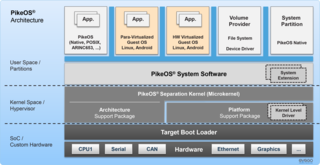Related Research Articles

In computer science, a microkernel is the near-minimum amount of software that can provide the mechanisms needed to implement an operating system (OS). These mechanisms include low-level address space management, thread management, and inter-process communication (IPC).

An operating system (OS) is system software that manages computer hardware and software resources and provides common services for computer programs.

In computing, a system call is the programmatic way in which a computer program requests a service from the kernel of the operating system it is executed on. This may include hardware-related services, creation and execution of new processes, and communication with integral kernel services such as process scheduling. System calls provide an essential interface between a process and the operating system.

The Blackfin is a family of 16-/32-bit microprocessors developed, manufactured and marketed by Analog Devices. The processors have built-in, fixed-point digital signal processor (DSP) functionality supplied by 16-bit multiply–accumulates (MACs), accompanied on-chip by a microcontroller. It was designed for a unified low-power processor architecture that can run operating systems while simultaneously handling complex numeric tasks such as real-time H.264 video encoding.
Operating systems based on the Linux kernel are used in embedded systems such as consumer electronics.
In computing, para-virtualization is a virtualization technique that presents a software interface to the virtual machines which is similar, yet not identical to the underlying hardware–software interface.

In computer science, hierarchical protection domains, often called protection rings, are mechanisms to protect data and functionality from faults and malicious behaviour. This approach is diametrically opposite to that of capability-based security.
A hybrid kernel is an operating system kernel architecture that attempts to combine aspects and benefits of microkernel and monolithic kernel architectures used in computer operating systems.

A live USB is a USB flash drive or external hard disk drive containing a full operating system that can be booted. They are the evolutionary next step after live CDs, but with the added benefit of writable storage on the live USB itself, allowing customizations to the booted operating system. Live USBs can be used in embedded systems for system administration, data recovery, or test driving, and can persistently save settings and install software packages on the USB device.

PikeOS is a commercial, hard real-time operating system (RTOS) that offers a separation kernel based hypervisor with multiple partition types for many other operating systems and applications. It enables users to build certifiable smart devices for the Internet of Things according to the high quality, safety and security standards of different industries.

Linux is a family of open source Unix-like operating systems based on the Linux kernel, an operating system kernel first released on September 17, 1991 by Linus Torvalds. Linux is typically packaged in a Linux distribution.

Gernot Heiser is a Scientia Professor and the John Lions Chair for operating systems at the University of New South Wales (UNSW). He is also leader of the Software Systems Research Group (SSRG) at NICTA. In 2006 he co-founded Open Kernel Labs to commercialise his L4 microkernel technology.

The kernel is a computer program that is the core of a computer's operating system, with complete control over everything in the system. On most systems, it is one of the first programs loaded on start-up. It handles the rest of start-up as well as input/output requests from software, translating them into data-processing instructions for the central processing unit. It handles memory and peripherals like keyboards, monitors, printers, and speakers.

The Linux kernel is a free and open-source, monolithic, Unix-like operating system kernel. The Linux family of operating systems is based on this kernel and deployed on both traditional computer systems such as personal computers and servers, usually in the form of Linux distributions, and on various embedded devices such as routers, wireless access points, PBXes, set-top boxes, FTA receivers, smart TVs, PVRs, and NAS appliances. While the adoption of the Linux kernel in desktop computer operating system is low, Linux-based operating systems dominate nearly every other segment of computing, from mobile devices to mainframes. As of November 2017, all of the world's 500 most powerful supercomputers run Linux. The Android operating system for tablet computers, smartphones, and smartwatches also uses the Linux kernel.

The Linux console is a system console internal to the Linux kernel. The Linux console provides a way for the kernel and other processes to send text output to the user, and to receive text input from the user. The user typically enters text with a computer keyboard and reads the output text on a computer monitor. The Linux kernel supports virtual consoles - consoles that are logically separate, but which access the same physical keyboard and display. The Linux console are implemented by the VT subsystem of the Linux kernel, and do not rely on any user space software. This is in contrast to a terminal emulator, which is a user space process that emulates a terminal, and is typically used in a graphical display environment.
The REX Operating System is an RTOS developed by Qualcomm for the ARM-based mobile phone Dual-Mode Subscriber Station (DMSS) or Advanced Mode Subscriber Software (AMSS) development. As of 2007 most Korean cell phones run on REX.
A virtual kernel architecture is an operating system virtualisation paradigm where kernel code can be compiled to run in the user space, for example, to ease debugging of various kernel-level components, in addition to general-purpose virtualisation and compartmentalisation of system resources. It is used by DragonFly BSD in its vkernel implementation since DragonFly 1.7, having been first revealed in September 2006, and first released in the stable branch with DragonFly 1.8 in January 2007. The long-term goal, in addition to easing kernel development, is to make it easier to support internet-connected computer clusters without compromising local security. Similar concepts exist in other operating systems as well; in Linux, a similar virtualisation concept is known as user-mode Linux; whereas in NetBSD since the summer of 2007, it has been the initial focus of the rump kernel infrastructure.
References
- 1 2 Staff. "Beta release of Kenge, Iguana and Wombat" . Retrieved 2010-03-12.
- 1 2 Leslie, Ben; van Schaik, Carl; Heiser, Gernot (April 2005). "Wombat: A portable user-mode Linux for embedded systems". Proceedings of linux.conf.au. Canberra (2005). Archived from the original (pdf) on 2016-10-21. Retrieved 2016-10-21– via https://ts.data61.csiro.au/publications/papers/Leslie_vSH_05.abstract.